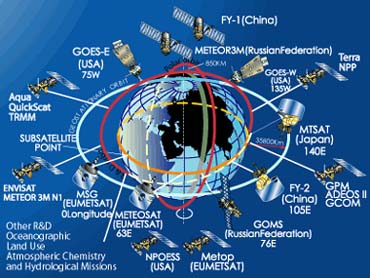| . |  |
. |
The European Space Agency has accepted an invitation to join an international group that coordinates the planning and data procedures of meteorological satellites. Called the Coordination Group for Meteorological Satellites (CGMS), the organisation provides a forum for meteorological satellite operators and others to come together explore ways to guarantee the maximum efficiency and usefulness of their systems on a global scale. In a related initiative, ESA has released an Announcement of Opportunity (AO) to encourage proposals from members of the World Meteorological Organization (WMO) to use data from ESA's Earth observation satellites in their various programmes. The AO will provide WMO members with a defined approach and access to Envisat and ERS satellite data, along with the capability to evaluate the impact of that data in their systems for future operational use. The invitation to ESA and other R&D agencies to join CGMS recognises the increasing interest of the meteorological community in the data provided by space missions designed for environmental and Earth sciences research, and to explore the applicability of innovative sensors to meteorology, according to Prof. Jos� Achache, ESA Director of Earth Observation.
 New space-based components of the Global Observing System "I see this membership as a fruitful extension of our collaborative efforts towards the international meteorological community," the ESA official stated in a letter of acceptance of CGMS membership to Dr Tillman Mohr, Director General of the European Organisation for the Exploitation of Meteorological Satellites (Eumetsat), which currently serves as the CGMS Secretariat. Prof. Achache added that he was keenly interested in harmonizing ESA's membership in the group with its existing cooperation in developing operational meteorological satellites for Eumetsat, as well as ESA's activities in the Committee on Earth Observation Satellites (CEOS) and the Integrated Global Observing Strategy (IGOS), two other international efforts to coordinate activities with the larger space and user communities. "ESA's acceptance of the CGMS invitation and our new Announcement of Opportunity to invite proposals from WMO members to use Envisat and ERS data is timely, as it almost coincides with this year's World Meteorological Day on 23rd March, which commemorates the 53rd anniversary of WMO," Prof Achache said. "Both WMO and ESA's Earth observation programme share similar objectives in ensuring that the most advanced climate data is available to assist countries around the world in areas such as water management, agriculture and disaster mitigation."
ESA founding member of CGMS Since then, CGMS was joined by WMO and by Eumetsat (which inherited the responsibility from ESA for operating European Meteosat satellites in 1986) along with the weather satellite operators in India, China, and the former Union of Soviet Socialist Republics. IOC, the Inter-governmental Oceanographic Commission of UNESCO became also a member about one year ago. Today, there are two major components of the current meteorological satellite network. The first consists of the various geostationary meteorological satellites operated by Europe, China, India, Japan, the U.S. and the Russian Federation. These satellites are placed around the equatorial belt at an altitude of approximately 36,000 km and provide a continuous and overall view of the weather systems roughly from 70 degrees North to 70 degrees South. The second element comprises the polar-orbiting satellites (at approximately 800-km altitudes) operated by the Russian Federation, the U.S. and China. It will be joined by a European system resulting from a partnership from ESA and Eumetsat, called MetOp, in 2005.
Announcement of Opportunity "These missions were designed for many other purposes, but the information is of clear use to meteorological scientists and weather services and they are very interested in obtaining it," Prof. Achache said. "Like our entry into CGMS, the Announcement of Opportunity will expand the number of potential users for Earth observation data in these communities." ESA's Earth observation missions could contribute, for instance, to atmospheric studies by offering data from Envisat's sensors designed to measure various chemical components in the Earth's atmosphere, for example:
The deadline for submission of proposals in response to the AO is 31 March 2003. The AO text and related material, including the joint WMO/ESA letter of announcement, can be found here. Related Links Announcement of Opportunity for WMO CGMS World Meteorological Organization MSG (Meteosat Second Generation) Envisat Results Envisat Instruments ERS MetOp Eumetsat ESA's Living Planet Weather classroom toolkit SpaceDaily Search SpaceDaily Subscribe To SpaceDaily Express  Huntsville - Feb 21, 2003
Huntsville - Feb 21, 2003Thin, wispy clouds, glowing electric blue. Some scientists think they're seeded by space dust. Others suspect they're a telltale sign of global warming. They're called noctilucent or "night-shining" clouds (NLCs for short). And whatever causes them, they're lovely.
|
| ||||||||||
| The content herein, unless otherwise known to be public domain, are Copyright 1995-2016 - Space Media Network. All websites are published in Australia and are solely subject to Australian law and governed by Fair Use principals for news reporting and research purposes. AFP, UPI and IANS news wire stories are copyright Agence France-Presse, United Press International and Indo-Asia News Service. ESA news reports are copyright European Space Agency. All NASA sourced material is public domain. Additional copyrights may apply in whole or part to other bona fide parties. Advertising does not imply endorsement, agreement or approval of any opinions, statements or information provided by Space Media Network on any Web page published or hosted by Space Media Network. Privacy Statement All images and articles appearing on Space Media Network have been edited or digitally altered in some way. Any requests to remove copyright material will be acted upon in a timely and appropriate manner. Any attempt to extort money from Space Media Network will be ignored and reported to Australian Law Enforcement Agencies as a potential case of financial fraud involving the use of a telephonic carriage device or postal service. |